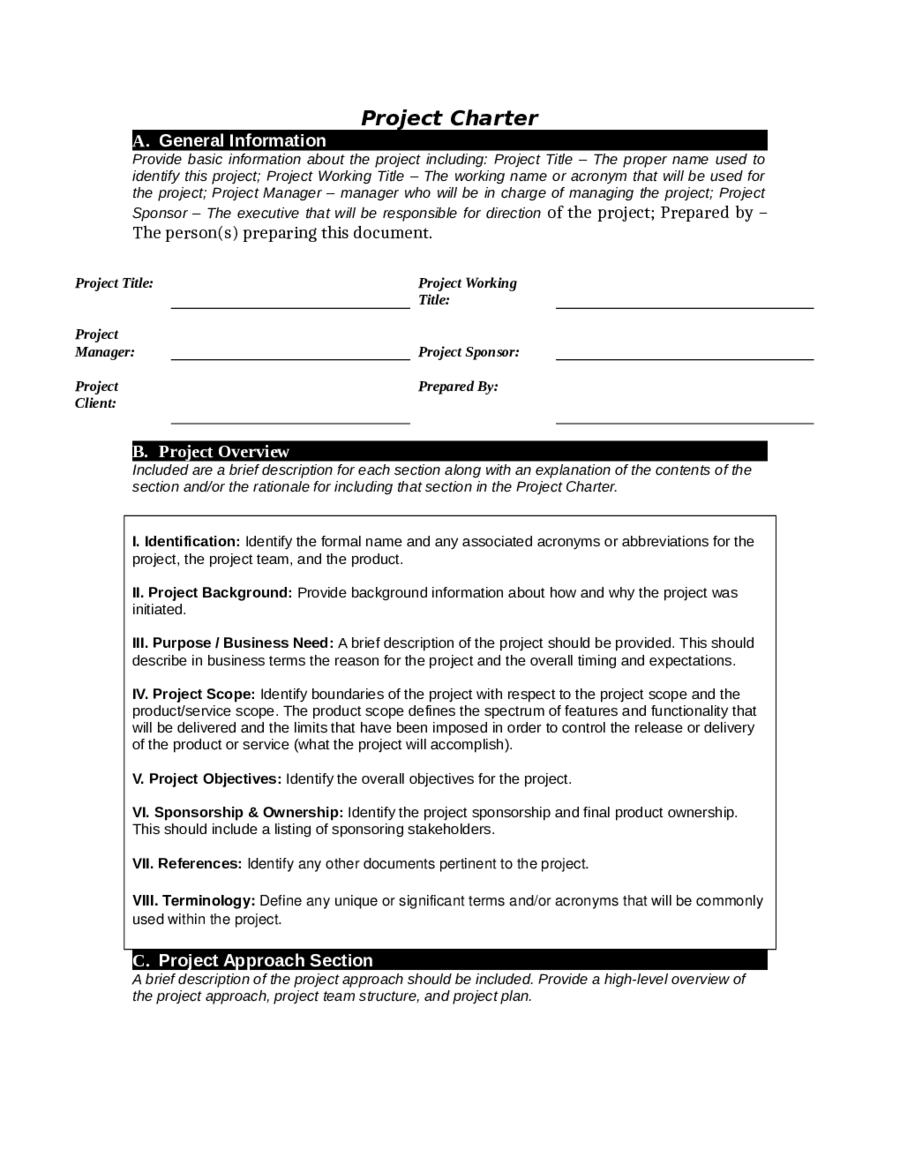Fillable Printable Project Management Charter Template
Fillable Printable Project Management Charter Template

Project Management Charter Template

Project Charter
A. General Information
Provide basic information about the project including: Project Title – The proper name used to
identify this project; Project Working Title – The working name or acronym that will be used for
the project; Project Manager – manager who will be in charge of managing the project; Project
Sponsor – The executive that will be responsible for direction of the project; Prepared by –
The person(s) preparing this document.
Project Title: Project Working
Title:
Project
Manager: Project Sponsor:
Project
Client:
Prepared By:
B. Project Overview
Included are a brief description for each section along with an explanation of the contents of the
section and/or the rationale for including that section in the Project Charter.
I. Identification: Identify the formal name and any associated acronyms or abbreviations for the
project, the project team, and the product.
II. Project Background: Provide background information about how and why the project was
initiated.
III. Purpose / Business Need: A brief description of the project should be provided. This should
describe in business terms the reason for the project and the overall timing and expectations.
IV. Project Scope: Identify boundaries of the project with respect to the project scope and the
product/service scope. The product scope defines the spectrum of features and functionality that
will be delivered and the limits that have been imposed in order to control the release or delivery
of the product or service (what the project will accomplish).
V. Project Objectives: Identify the overall objectives for the project.
VI. Sponsorship & Ownership: Identify the project sponsorship and final product ownership.
This should include a listing of sponsoring stakeholders.
VII. References: Identify any other documents pertinent to the project.
VIII. Terminology: Define any unique or significant terms and/or acronyms that will be commonly
used within the project.
C. Project Approach Section
A brief description of the project approach should be included. Provide a high-level overview of
the project approach, project team structure, and project plan.

I. Project Deliverables and Quality Objectives: Provide a list of major and key
deliverables that will be generated during and on completion of the project. Identify key
milestones. For each deliverable, provide a description of its quality objectives in terms
of output quality and approval requirements.
II. Organization and Responsibilities: This section identifies the required Project
Team and, taking the project skill requirements into account, assigns roles and
responsibilities to named individuals. At a minimum, this section should address the
Business Leader, Project Manager, and the Executive Committee.
III. Reporting, Oversight, & Review: Reporting relationships and project interfaces
should be described within this section. Identify required approvals and interfaces with
organizations such as procurement.
IV. Dependencies: Any dependencies outside of the Project Manager's direct control,
or outside of the scope of the project (but which may influence the project success)
should be identified.
V. Plans for Support Activities: Plans for project support activities are described here.
VI. Project Facilities and Resources: The project's requirements for facilities and
resources are described here.
VII. Risk Management: Any risks associated with the project and the actions that can
be taken during the project to minimize the risks need to be identified.
VIII. Process Options and Deviations: A defined Project Management Methodology
and Systems Development Life Cycle Methodology should be identified by reference in
this section.
IX. Process Stages: A description of the project life cycle should be detailed here. For
each life cycle phase, applicable procedures, methods, and standards should be
referenced or identified.
X. Project Control: Project control explains the methods and processes that will be
implemented to assist the Project Manager in identifying project progress and
communicating that progress to the project team, project sponsor, and project
stakeholders. This section should also identify the methods and policies to be used for
project scope control, issue management, and change and configuration management.

Project Approach Section Continued
A brief description of the project approach should be included. Provide a high-level overview
of the project approach, project team structure, and project plan.
D. Approval Section
This section identifies the names and roles of the major project stakeholders and indicates their
approval of the project charter.
E. Appendices
Changes to the original Project Charter must be signed by the appropriate parties and included in
this section.
XI. Quality Assurance and Control Activities: Quality assurance and control
activities relate to both the project management processes and deliverables, and the
product development processes and deliverables. A list of the quality reviews and
quality tests that will be carried out during the project should be included.
XII. Project Schedule: Include a high-level schedule for the project.
XIII. Project Cost Estimate: This section outlines the estimated project cost
Signatures are included in this section.
Other appendices should include a fully developed and completed business case,
additional agreements, and other documents related to project scope, cost, and
schedule.



